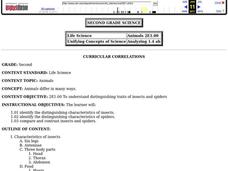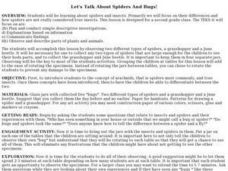Curated OER
Arthropods at Home: Spider, Isopod, or any Arthropod
Second graders observe, discuss, and record the requirements of a healthy environment for both arthropods and people by designing and maintaining an artificial habitat for an arthropod, and considering the requirements for a healthy body...
Curated OER
The Very Busy Spider Art Project
Students listen to the story The Very Busy Spider and participate in an art activity related to the book. In this story inspired art lesson, students use a Very Busy Spider printable and cut out the spider's body and connect...
American Museum of Natural History
Bio-Benefits
Kick-start a discussion of the importance of biodiversity with a colorful resource that touts the benefits of maintaining healthy ecosystems. The images stress the interdependence of all the elements of an ecosystem.
Science Friday
Ugh, a Bug!
Young entomologists familiarize themselves with the physical characteristics of insects. Composed of two activities, each instructional activity involves your scientists tapping into their prior knowledge of bugs and making observations...
Center for Technology in Teaching and Learning
CSI: The Experience - Family Forensics
Forensic scientists depend on their observation skills to analyze evidence down to the molecular level. Middle and high schoolers practice making observations and predictions with a series of crime scene activities, which includes a...
Curated OER
Anatomy of the Texas Brown Tarantula
In this Texas brown tarantula instructional activity, students examine the 7 labeled parts of the spider. The parts include spinnerets, abdomen, cephalothorax, leg, eyes, pedipalp, and chelicerae.
Curated OER
Animals
Second graders explore the ways in which animals differ. They discuss the characteristics of insects and spiders. Students identify the characteristics of insects and spiders. They compare and contrast insects and spiders.
Curated OER
Night Creatures of the Kalahari
Learners conduct an experiment to demonstrate how fruit fly populations are controlled by spiders. They observe a variety of environments with fruit flies and spiders and consider how vital spiders are to controlling the insect population.
Curated OER
Have You Ever Wondered?
Students use their personal knowledge and the Internet to discover where and how spiders live. In groups, they discuss their experiences with spiders and how their lives differ from other insects. They use new vocabulary to discuss their...
Curated OER
Introduction To Bug Collecting
Students explore process of live collection of insects and spiders using sweep nets, aerial nets, and beating sheets. they collect, examine and release several different types of insects or spiders then compare their journal drawing of...
Curated OER
Mini Worlds
In this insects instructional activity, students 18 questions regarding butterflies, moths, bees and spiders. A print out version of this instructional activity is available, but the online version contains links to various webpages with...
Curated OER
Meet the Tarantula
Students study tarantulas. In this tarantula lesson, students discover the general description of the arachnid as well pointers regarding its behavior, reproduction, habitat, food schedule, and handling tips.
Curated OER
Be an Artist: Backswimmer
In this science worksheet, 3rd graders will use visual clues in a grid to complete an exact image replica. Following the original line segments in each box, students will create the image of a backswimmer.
Curated OER
Let's Talk About Spiders And Bugs!
Second graders study the differences between spiders and insects. They observe four different specimens in the classroom.
Curated OER
Picture Scramble: Spider Crab, Sea Nettle, Clearnose Skate
In this science and visual discrimination worksheet, pupils examine images of a spider crab, seat nettle and clearnose skate. Next to each picture is the same image which has been divided into 9 pieces and scrambled. Students place the...
Curated OER
Science Quiz-General Knowledge
In this science quiz worksheet, learners complete a set of 20 true or false questions covering a variety of general science topics. An answer key is included.
Curated OER
Hatched From An Egg
Students discover how animals are born/hatched. In this life science lesson, students listen to a book entitled Chickens Aren't The Only Ones, and discuss animals that are hatched or born. Students receive a picture of an animal,...
Curated OER
Human Inventions with Animal Features
In this animal features learning exercise, students match different animal features with the human invention that is similar. Students match 9 inventions and then complete 3 short answer questions.
Curated OER
Living Systems Part III
Here is a fantastic, informative, interactive presentation on plant and animal cells. The PowerPoint is produced by an elementary school teacher who has a doctorate in science, and it shows! This would be a splendid presentation to use...
Curated OER
Diversity of Arthropods
In this arthropods worksheet, students will review the characteristics of the different types of arthropods including spiders, ticks, crustaceans, millipedes, and insects. Students will also understand the difference between complete and...
Curated OER
Arthropod Coloring
In this arthropod worksheet, students compare and contrast the different animals found in the Phylum Arthropoda: insects, arachnids, and crustaceans. Students complete 8 fill in the blank statements and color illustrations.
Curated OER
Solid Waste Recycling
Students seek scientific and technological solutions to envrionmental problems. They record class activities in a journal. They identify relationships among living things and their environments.
Curated OER
Desert Creepy Crawlies- Research Skills
In this science instructional activity, students research information about 4 desert animals and write facts on the lines. Students write information about the Hercules Beetle, Harvester Ants, Giant Red Velvet Mites and Yucca Moths.
Curated OER
Sampling and Comparing Biodiversity
High schoolers compares the density and distribution differences of four species of spiders in two hypothetical habitats. They "sample" two habitats and then do calculations such as average density and relative distributions to compare...
Other popular searches
- Spiders and Science
- Life Science Spiders
- Science Spiders vs Insects
- Earth Science Spiders
- Elementary Science Spiders
- Physical Science Spiders























